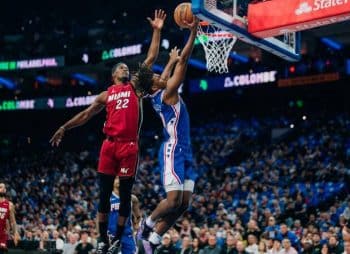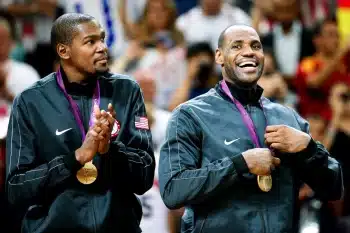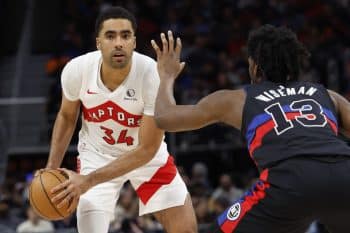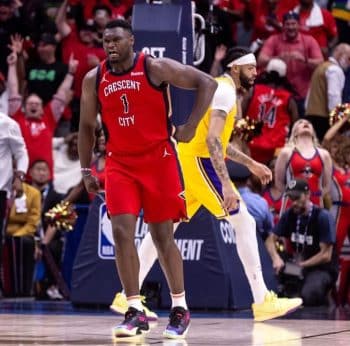NBA
End of an Era? Time for NY to Move Carmelo

In the tricky terrain that is today’s NBA, there are only two destinations worth travelling toward.
Smart, successful organizations are fully, wholly committed to one of two goals: Finishing first or finishing last. The teams that know they have a legitimate shot to capture the crown can, without regret, dedicate their resources to acquiring assets that pay immediate dividends, placing ultimate importance on short-term success. On the other hand, organizations that recognize they don’t yet have the pieces in place to win it all as currently constructed will think long-term and focus on the future.
If an organization hasn’t set up camp at either oasis (potential title contender or lottery loser) they find themselves sinking in the deadly quicksand that is the middle-ground of the NBA’s vast desert.
It’s become a cliché in basketball circles because it’s true: “The absolute worst position to be in the NBA is a team fighting for the eighth seed.” This means you aren’t good enough to win a championship; nor are you bad enough to land a top pick in the draft.
And that’s why it’s in the Knicks’ best interest to trade their two best players, Carmelo Anthony and Tyson Chandler, by next month’s trade deadline.
The Knicks’ record stands at an abysmal 15-26. Despite playing in the worst division in arguably one of the worst conferences in recent NBA history, the Knicks have somehow fallen 11 games under .500.
Because there are so many other bad teams in the conference, New York has a decent chance to qualify for the postseason. In fact, they even have a shot to win the Atlantic Division. However, anyone that has eyes and has watched this team play basketball this season is well aware the Knicks are simply not capable of beating the Indiana Pacers or the defending champion Miami HEAT in a postseason series.
Still, it is important to note that the fact that the Knicks have stunk this season is NOT a direct reflection on Carmelo Anthony. Anthony has played hard, and he’s one of the few Knicks that have competed on a nightly basis. You wouldn’t know it by looking at his team’s record, but Anthony has played extremely well this season. In fact, he is on pace to become just the second NBA player in the last 10 seasons to average at least 26 points, nine rebounds and three assists per game.
And if the Knicks’ goal is to sneak into the 2014 postseason and pretend they have a chance to win the title, then they need to hold onto Anthony and hope he puts the entire team on his back and at least keeps the Knicks competitive, so that they are playing meaningful games in April.
However, if the Knicks want to put themselves in the best position to win an NBA championship before the end of this decade, they have to sacrifice short-term success in order to do what’s best for the long-term prosperity of the franchise.
February 20th, 3 p.m. EST. That’s the date of the NBA’s trade deadline.
If Anthony is still a Knick on February 21st, the ball will no longer be in the Knicks’ court. Melo will hold all the cards at that point.
The next momentous decision will be made by Anthony. He is scheduled to earn $23.3 million during the 2014-15 season but has an early termination option in his contract, which means he can choose to squash the final year of that deal and become a free agent in the summer of 2014.
It is certainly safe to assume that Anthony will be advised by his agents to make the fiscally prudent decision to opt out and become a free agent, which would allow him to sign a new long-term contract with far more guaranteed money.
Most pundits have also assumed Anthony, considering his skill set and star power in the Big Apple (and the fact that this will be his final opportunity land major money), will seek a max contract from the Knicks.
So, assuming he’s still on the Knicks’ roster the day after the deadline, there are basically two realistic scenarios remaining.
After he opts out on and becomes a free agent on July 1, (a) the Knicks re-sign Melo for max money, or (b) he chooses to sign with another team (for less money and fewer guaranteed years).
If Anthony does decide to skip town via free agency, the Knicks would be left with nothing to show for a player they mortgaged their future to acquire just a few short years ago. (Reminder: If Anthony does choose to leave, the Knicks likely wouldn’t be able to facilitate a sign-and-trade, even if all three parties were amenable to it because the new CBA has such harsh restrictions related to all S&T deals).
But, amazingly, that might not be the worst-case scenario.
If the Knicks did end up re-signing Anthony to a maximum-level contract, it might, in reality, be more damaging to the long-term health of the franchise. And here’s why…
Here are the particulars of what a max contract for Anthony would look like:
In year one of his new deal, Anthony can earn 105 percent of his 2013-14 salary. So, the first year (2014-15) of his new contract would pay $22.457 million (105 percent of $21.39 million).
Because the Knicks own Anthony’s Bird rights, they can increase his salary by 7.5 percent of his first year’s salary, and 7.5 percent of $22.457 million is $1.684 million. If they give him the maximum allowable raise, his yearly salaries would be as follows:
2015-16: $24.141 million
2016-17: $25.825 million
2017-18: $27.509 million
2018-19: $29.193 million
Yes, you read that correctly. During the fifth and final season of a potential new max contract (after he had already celebrated his 34th birthday) Anthony would make over $29 million.
How effective and efficient will a 34-year-old Anthony be? How many starting small forward in the league would Anthony be able to even stay in front of in 2019? Well, he better be incredible, considering he’d be taking up nearly 50 percent of the Knicks’ salary cap that season.
Anthony, at 29 years of age, is firmly is his prime right now. Yet, even with Melo healthy and at the peak of his offensive powers, the Knicks still possess one of the league’s worst records. Again, the team’s ineptitude can not be pinned solely on Anthony, but their record is what it is. If the Knicks hand Anthony a max contract, his salary (and, accordingly, his percentage of the cap) will only increase, while his production and all-around efficacy decreases.
Is that a recipe for a future success? Based on the evidence at our disposal, is this an intelligent investment of $129 million?
And before we get to the back end of that deal, his cap hit for the 2015-16 season would be prohibitive to the Knicks making major improvements during the all-important summer of 2015. Building toward the ‘Summer of 2015’ would be the impetus behind moving on without Anthony.
Trading Carmelo, the Knicks’ best and most marketable player since Patrick Ewing, would obviously be difficult for Knicks management to sell to their fans. Empty seats inside Madison Square Garden and sagging television ratings would also be an understandable concern for Knicks ownership.
But the promise of a better, brighter future would be the selling point. In addition, it should be noted that the Knicks have never had an issue putting people in the arena. Even during the nadir of the nightmarish Isiah Thomas era, the Garden still played to over 95 percent capacity on most nights. The myth that New Yorkers won’t accept and embrace a rebuilding project is just that – a myth.
Knicks management has had July 2015 circled on their calendars for a long time now. New York will shed major salary from their books at that time. The 2014-15 season is the final year on the contracts of Amar’e Stoudemire, Tyson Chandler and Andrea Bargnani. New York will clear a whopping $49.6 million in salary in one fell swoop. As a result, the Knicks could potentially be a major player in the free-agent market that summer.
If Anthony is not taking up $24.1 million, New York could be looking upwards of $45 million in cap space, which would allow them to go on quite the shopping spree that summer. Of course, they won’t have to spend it all in one place (or on one player). Smart organizations understand the true value of cap space is that it enables teams to trade for high-priced players, as well as sign top free-agents outright.
Some have argued that retaining Anthony would improve the Knicks’ chances of signing other free agents. However, couldn’t it also be argued that free agents capable of seeing the big picture would prefer to sign with New York knowing the team does not have $129 million committed to a talented but one-dimensional player in his 30’s? Moreover, New York sports franchises, when they have the money under the cap to spend, have never had a hard time convincing top-tier talent to come live and play in NYC.
Make no mistake, there is an undeniable and obvious downside to trading Anthony. The Knicks would tumble further down the standing this season, made all that much tougher knowing the team has already traded away their 2014 draft pick. New York would then also have to endure another depressing, losing season in 2014-15, as the Knicks would still be over the cap this upcoming summer and would therefore be unable to sign a big-name free agent.
Yet, there would be one ancillary benefit to a terrible 2014-15 campaign, as the Knicks actually own their 2015 draft pick. So, if the Knicks posted a terrible record next season, they would be in line to reap the reward of a lottery pick. Thus, New York would head into the summer of 2015 with a high selection in the draft and loads of cap space to lavish on a potentially solid free agent crop (and Basketball Insiders recently wrote about why the 2015 draft may actually be better than 2014).
Yes, it’s certainly a gamble. But it would also be inherently risky to hope the Knicks can realistically compete for an NBA title with Anthony making upwards of $26 million annually.
There is a possibility that Anthony would be willing to re-sign with Knicks in July for less than the maximum, but most would agree that is unlikely. Most superstars, when they have to the opportunity to cash in, tend to take advantage of that opportunity. We’ve just recently seen Kobe Bryant, at age 35, sign a two-year extension worth $48.5 million. So, unless Anthony all-but guarantees Knicks owner Jim Dolan that he will re-sign with New York next summer and do so at significantly less than the max, it behooves the Knicks to start working the phones immediately.
Of course the Knicks will get far less than equal value back in any deal they make. Opposing GM’s will be extremely hesitant to give up too much for Anthony, knowing that he could be just a short-term rental. Still, as outlined above, getting back even 30 cents on the dollar for Melo in February beats the alternatives of keeping him past the deadline. Dolan and Knicks GM Steve Mills could seek some combination of future draft picks and/or young players locked into affordable contracts.
In addition, because the Knicks will be over the cap next year anyway, they could also take back a bad contract as long as it had just one more year left on the deal. Again, the new focus and goal would be maximizing cap space for 2015. For instance, if a contending team was desperate to clear money off their books this summer, they might be willing to pay a premium to trade away a bench player with big money due in 2014-15 in exchange for Anthony and his expiring contract. Of course, the Knicks would also require quality draft picks back in such a deal.
And if the Knicks did decide to preemptively part ways with Anthony, it would make sense to then also explore other trade options involving other older, desirable players. For instance, if New York put Tyson Chandler on the block, he’d drawn plenty of interest from around the league. The former Defensive Player of the Year is a proven winner, with a championship ring to prove it. He would immediately improve the defensive integrity of any team he joined, and could be a difference-maker that puts a contender over the top this season or next.
If the Knicks got serious offers for Anthony or Chandler, they could then attempt to further improve their 2015 cap situation by crow-barring either Raymond Felton or J.R. Smith in a potential deal. As it stands today, there are only four players that will likely be on the Knicks books past the 2014-15 season: Pablo Prigioni ($1.7 million), Tim Hardaway Jr. ($1.3 million), Raymond Felton ($4.5 million player option) and J.R. Smith ($6.4 million player option). There is also a $3.8 million qualifying offer for Iman Shumpert the Knicks will have to make a decision on. As we now know, the Knicks wouldn’t be opposed to including Shumpert in a trade if the return was right.
With creating the most cap space in 2015 as the stated objective, maybe the Knicks make their trading partner also take on Felton or Smith a perquisite in any deal for Melo?
With the team drastically underperforming this season, and cap-strapped through next year, there are no easy answers or quick-fixes for the Knicks. Dolan and Mills have the make the best of a difficult situation.
At some point, the Knicks organization needs to stop attempting to re-arrange deck chairs on the Titanic. Allow this vessel to sink, and then build a completely new ship with more affordable parts.
The best possible solution may be taking a couple steps backwards today, which will allow them to take a few major steps forward in the future.











